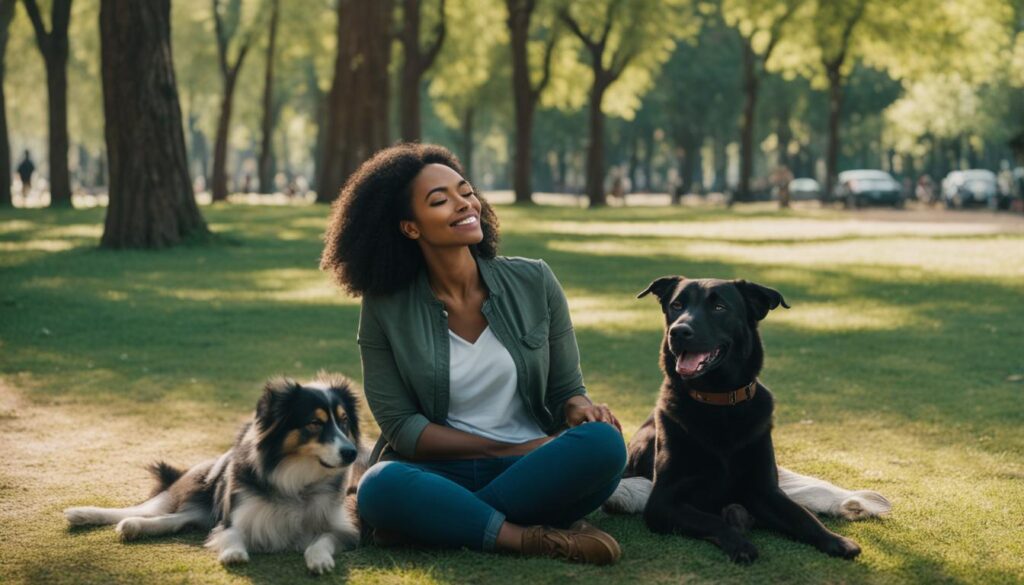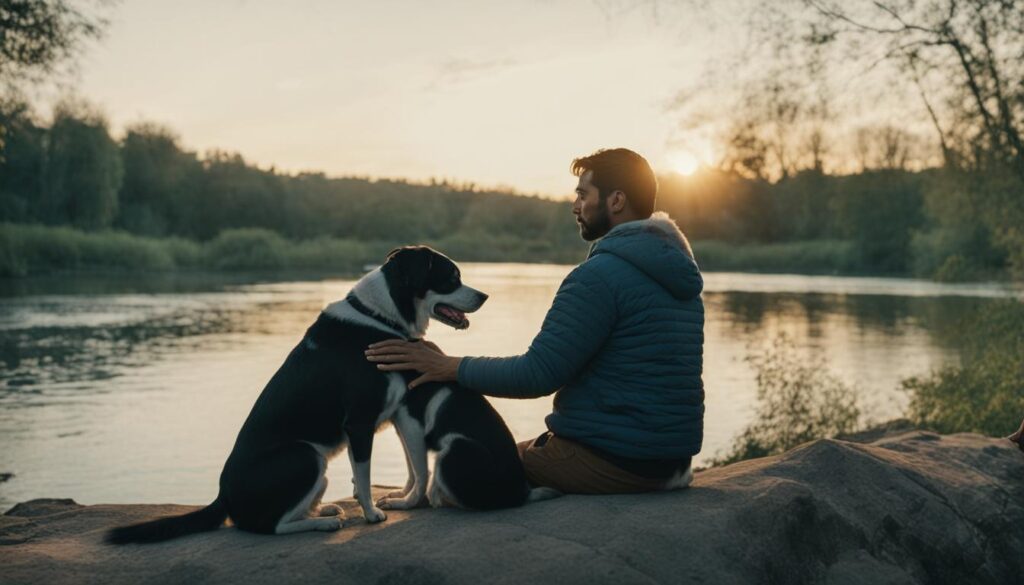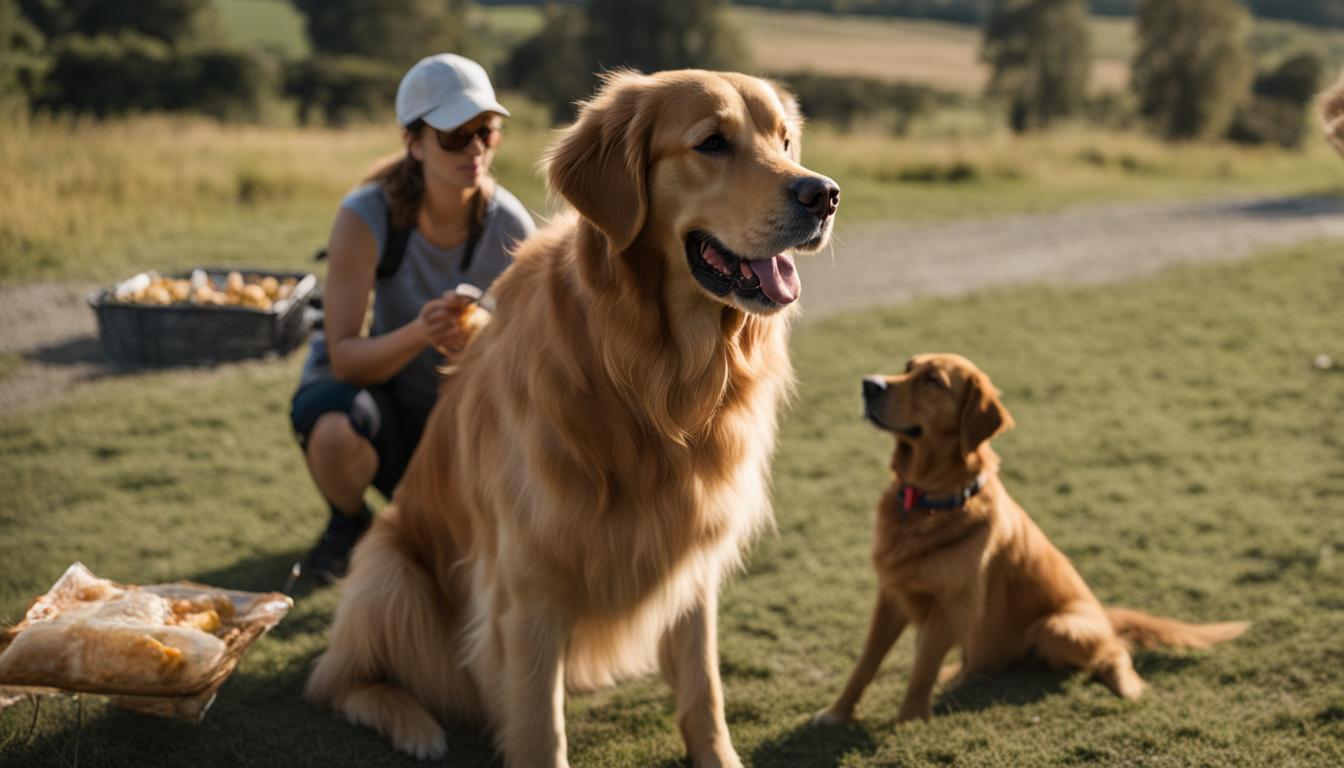Have you ever wondered Why Does My Dog Ignore Me? It's a common question among dog owners, and understanding the reasons behind this behavior can help you strengthen your bond with your furry companion.
In this article, I will explore the factors that contribute to a dog's obedience and share valuable insights and tips on how to enhance communication, build trust, and establish effective leadership with your dog.
Key Takeaways:
- Understanding why your dog listens only to you can help strengthen your bond.
- Training and effective communication are key to gaining your dog's obedience.
- Consistency, positive reinforcement, and clear commands are essential in training.
- Building trust and establishing leadership is crucial for a strong dog-owner bond.
- Every dog is unique, and training requires patience, time, and consistency.
9 Reasons Why Does My Dog Ignore Me & What To Do
When your dog ignores your commands, it can be frustrating and confusing. However, there are several reasons why this behavior may occur. Understanding these reasons and addressing them with appropriate training and behavior modification techniques can help improve your dog's responsiveness and strengthen the bond between you. Here are 16 common reasons why your dog may ignore you and what you can do about it:
- Canine Distractions: Dogs have a keen sense of smell and hearing, which means they may become easily distracted by their environment, such as other animals, scents, or noises.
- Lack of Training: Dogs need consistent training to understand and obey commands. If your dog hasn't received proper training, they may not fully comprehend what is expected of them.
- Fear and Anxiety in Dogs: Dogs that are fearful or anxious may be too stressed to focus on commands. It's important to address and manage their fear and anxiety to improve their responsiveness.
- Pain or Discomfort in Dogs: Dogs in pain or discomfort may find it difficult to follow commands. If your dog is exhibiting signs of pain or discomfort, consult with a veterinarian to address their needs.
- Negative Associations With Commands: If your dog has had negative experiences or punishments associated with certain commands, they may start ignoring those commands to avoid unpleasant outcomes.
- Age-Related Changes in Dogs: As dogs age, their cognitive abilities may decline, resulting in reduced responsiveness to commands. Adjusting training techniques to accommodate their changing needs can help.
- Lack of Exercise for Dogs: Dogs with excess energy may struggle to focus on commands. Providing regular exercise and mental stimulation can help alleviate their restlessness.
- Lack of Socialization in Dogs: Proper socialization is crucial for dogs to learn appropriate behavior and respond to commands in various environments. Inadequate socialization can lead to avoidance or disinterest.
- Inconsistent Rewards and Consequences for Dogs: Inconsistency in rewarding desired behavior and enforcing consequences for undesirable behavior can confuse dogs and make them less likely to listen to commands.
Frequent Distractions
One common reason for a dog to ignore their owner is frequent distractions. Dogs are curious creatures, and their senses are highly attuned to their surroundings. They may become easily distracted by sights, sounds, and smells, causing them to divert their attention away from their owner's commands. It's important to minimize distractions when training your dog and gradually introduce environmental stimuli to improve their focus and obedience.
Addressing Fear and Anxiety
Fear and anxiety can significantly impact a dog's ability to listen and respond to commands. It's crucial to create a calm and safe environment for your dog and address any underlying fears or anxieties. Positive reinforcement techniques, patience, and desensitization exercises can help your dog feel more comfortable and confident, leading to improved responsiveness.
Training Techniques and Consistency
Lack of proper training and inconsistency can contribute to a dog's tendency to ignore their owner. By implementing effective training techniques, such as positive reinforcement and clear communication, you can build a strong foundation for your dog's obedience. Consistency is essential, as dogs thrive on routine and repetition. By setting clear expectations and consistently reinforcing desired behaviors, you can encourage your dog to listen and respond to your commands.
By understanding and addressing the reasons why your dog ignores you, you can take proactive steps to improve their responsiveness. Remember, patience, consistency, and positive reinforcement are key when training your dog. With time, effort, and a strong bond, you can establish effective communication and build a harmonious relationship with your furry companion.
| Reasons Why Your Dog Ignores You | What To Do |
|---|---|
| Canine Distractions | Minimize distractions during training and gradually introduce environmental stimuli. |
| Lack of Training | Provide consistent and effective training to help your dog understand and obey commands. |
| Fear and Anxiety in Dogs | Create a calm and safe environment, address underlying fears and anxieties, and use positive reinforcement techniques. |
| Pain or Discomfort in Dogs | Consult with a veterinarian to address any pain or discomfort your dog may be experiencing. |
| Negative Associations With Commands | Rewire your dog's associations, use positive reinforcement, and avoid punishments. |
| Age-Related Changes in Dogs | Adjust training techniques to accommodate your dog's changing cognitive abilities. |
| Lack of Exercise for Dogs | Provide regular exercise and mental stimulation to help your dog release excess energy. |
| Lack of Socialization in Dogs | Ensure proper socialization and exposure to various environments to improve responsiveness. |
| Inconsistent Rewards and Consequences for Dogs | Be consistent in rewarding desired behavior and enforcing consequences for undesirable behavior. |
How to Train Your Dog to Stop Ignoring You
Training plays a crucial role in addressing a dog's tendency to ignore its owner. By utilizing effective training techniques, such as positive reinforcement, consistency, clear communication, and the use of rewards and treats, owners can successfully train their dogs to listen and respond to commands.
- Positive Reinforcement: Emphasize positive reinforcement by rewarding desired behaviors. Praising and giving treats when your dog follows commands will reinforce their understanding and motivation to listen.
- Consistency: Consistency is key in dog training. Make sure to establish a consistent routine and use the same commands for specific actions. This will help your dog understand what is expected of them and reduce confusion.
- Clear Communication: Dogs rely on clear communication from their owners. Use concise, consistent verbal cues and hand signals to convey commands effectively. Remember to be patient and provide clear guidance during training sessions.
- Rewards and Treats: Rewards and treats are powerful motivators for dogs. Utilize them as positive reinforcements during training sessions to encourage listening skills. Gradually reduce the reliance on treats as your dog becomes more proficient at following commands.
One specific example of training a dog to stop ignoring you is teaching them to come when distracted. Start by practicing in a quiet, controlled environment. Once your dog consistently responds to the “come” command, gradually introduce distractions, such as toys or other dogs, to simulate real-life scenarios. Slowly increase the difficulty level, ensuring your dog's focus and obedience regardless of the distractions.
Training your dog to stop ignoring you requires patience, consistency, and a positive approach. Celebrate small victories along the way and remember that each dog learns at their own pace. With time and dedication, you can strengthen the bond with your furry companion and enjoy a harmonious relationship based on clear and effective communication.
| Training Techniques for Listening Skills | Positive Reinforcement | Consistency in Dog Training | Clear Communication with Dogs | Rewards and Treats in Dog Training | Training Dogs to Come When Distracted |
|---|---|---|---|---|---|
| Use positive reinforcement to motivate and reward desired behaviors. | Reinforce good behavior with praise, treats, and affection. | Maintain a consistent training routine and use the same commands for actions. | Use clear verbal cues and hand signals to effectively communicate commands. | Utilize rewards and treats as positive reinforcement during training sessions. | Teach dogs to respond to the “come” command even in distracting environments. |
| Focus on understanding and addressing your dog's needs, motivations, and psychology. | Encourage and reward desired behaviors while ignoring or redirecting unwanted behavior. | Establish clear rules and boundaries to create a structured training environment. | Pay attention to your dog's body language and adjust your communication accordingly. | Vary the types of rewards and treats to keep your dog engaged and motivated. | Gradually introduce distractions to reinforce obedience in distracting situations. |
What to Do When Your Dog Ignores You
When faced with a situation where your dog ignores you, it is essential to assess the underlying reasons for this behavior. Understanding the root cause can help determine the most effective approach for addressing the issue and improving communication with your furry friend.
Assessing the situation involves carefully observing your dog's behavior and environment. Consider factors such as distractions, fear or anxiety, health issues, or previous negative associations with commands. By identifying the specific triggers that contribute to your dog's behavior, you can tailor your training efforts accordingly.
In my experience, positive reinforcement is a highly effective technique for encouraging desired behavior in dogs. Instead of resorting to negative reinforcement methods, such as punishment or scolding, focus on providing rewards and praise when your dog obeys your commands or shows desired behaviors. This positive approach creates a rewarding and enjoyable training experience for your pet, strengthening the bond between you and encouraging improved listening skills.
Consistency is key when working with a dog that ignores you. It is important to establish clear expectations and consistently reinforce them. Use the same commands and signals each time, and follow through with appropriate rewards or consequences. By providing consistent guidance, your dog will develop a better understanding of what is expected of them.
“Training a dog to listen may require patience and consistent effort.”
Training a dog to stop ignoring you requires patience and consistency. It may take time for your dog to develop new habits and fully understand your expectations. Be prepared to invest time and effort into regular training sessions, using positive reinforcement techniques and providing clear communication. Celebrate small victories along the way and be patient with your furry companion. Remember, building a strong bond and improving obedience is a journey that requires dedication and understanding.
By assessing the situation, using positive reinforcement, and maintaining patience and consistency, you can effectively address the issue when your dog ignores you. With time and training, your furry friend will become more attentive and responsive, strengthening the bond between you and creating a harmonious relationship based on trust and understanding.
Why Won't My Dog Listen? Common Questions Answered
Dog owners often find themselves frustrated when their furry companions don't listen to them. If you've been asking yourself, “Why won't my dog listen?” you're not alone. Here, we address some common questions and provide insights and tips to help you better understand and improve your dog's obedience.
How to Get Your Dog's Attention
To get your dog's attention, try using positive reinforcement techniques. Use treats or toys as rewards for desired behaviors, and make sure to praise and pet your dog when they respond to your commands. Additionally, ensure that you are in a calm and distraction-free environment when giving commands to increase their focus.
Remember, consistency is key in dog training. Use the same cues and commands every time to avoid confusion.
Reasons for Dog Ignoring Their Owner
There can be various reasons why your dog ignores you. It could be due to distractions in the environment such as other animals, noises, or smells. Dogs might also ignore their owners if they haven't received proper training or socialization, leading to a lack of understanding of commands.
Furthermore, some dogs may only listen when food is present because they associate commands with rewards. If you've been unintentionally reinforcing this behavior, it's important to address it by gradually decreasing reliance on treats during training sessions.
Lastly, it's essential to understand that dogs don't intentionally ignore their owners. Instead, their behavior may be a result of various factors such as fear, anxiety, or even medical issues. Identifying and addressing these underlying causes is crucial to improving your dog's response to your commands.
Expert Advice
“Remember that every dog is unique in their learning process. It's important to be patient, consistent, and understanding when training your dog. Celebrate their progress and continue to reinforce positive behaviors.” – Dr. Samantha Thompson, Certified Dog Trainer
By addressing the reasons why your dog might be ignoring you and implementing effective training techniques, you can strengthen the bond with your furry friend and improve their responsiveness. Remember to be patient, and consistent, and offer positive reinforcement to encourage desired behaviors.
Final Thoughts on Dog Obedience
Dog obedience is a crucial component of the dog-owner relationship. By building trust with your dog, establishing effective communication, and enhancing the bond between you and your furry friend, you can strengthen obedience and create a harmonious partnership.
Training your dog takes time and consistency. Each dog is unique in their learning process, so it's important to be patient, and understanding, and approach the training with a positive mindset. Remember, your dog wants to please you and be a good companion.
Building Trust with Your Dog
Trust is the foundation of any successful relationship, including the one you have with your dog. To build trust:
- Show your dog love and affection consistently.
- Establish clear boundaries and rules.
- Be a consistent and reliable presence in your dog's life.
- Provide a safe and nurturing environment for your dog.
By building trust, your dog will feel secure and confident, making them more receptive to your commands and training.
Effective Dog Communication
Communication is key in any relationship, including the one between you and your dog. To effectively communicate with your dog:
- Use clear and consistent verbal commands.
- Pay attention to your body language and use it to convey your expectations.
- Reinforce positive behavior with praise and rewards.
- Redirect undesirable behavior using gentle corrections.
By communicating effectively with your dog, you will establish a deeper understanding and connection, making training easier and more successful.
Enhancing the Dog-Owner Bond
The bond between you and your dog is built through shared experiences, love, and positive interactions. To enhance the bond:
- Engage in regular playtime and exercise together.
- Create opportunities for bonding activities, such as obedience training or interactive games.
- Spend quality time with your dog, offering attention and affection.
- Be a source of comfort and security for your dog.
By strengthening the bond between you and your dog, you will create a foundation of trust and loyalty, leading to increased obedience and a happier, healthier relationship.


Low Engagement and Environmental Distractions
Some dogs may have a tendency to display low engagement levels with their owners, which means they find their surroundings more captivating than human interaction. This can be due to their temperament or a lack of proper training and socialization. When dogs are exposed to environmental distractions, it can further hinder their focus and responsiveness to their owner's commands. To address the issue of a dog ignoring its owner, it is crucial to understand these factors and take appropriate measures to enhance engagement and minimize distractions.
Canine Temperament and Low Engagement
Dogs, like humans, have unique individual temperaments. Some dogs may naturally have lower engagement levels, making it harder for them to focus solely on their owners. This can be attributed to a variety of factors, including genetics, past experiences, or even a lack of mental stimulation. It is important to understand and respect a dog's temperament while providing the necessary training and socialization to foster a stronger bond and increase engagement levels.
Impact of Environmental Distractions
Environmental distractions play a significant role in a dog's ability to concentrate on their owner's commands. Dogs are naturally curious creatures, and their heightened senses are attuned to various stimuli in their surroundings. Common environmental distractions for dogs can include other animals, loud noises, unfamiliar scents, or even visually appealing objects. These distractions can divert a dog's attention away from their owner, making it challenging for them to respond and obey commands.
Training and Socialization for Improved Engagement
Training and socialization are crucial components in addressing low engagement and minimizing the impact of environmental distractions on a dog's responsiveness to their owner. Consistent and positive reinforcement training techniques can help keep the dog's attention focused on their owner, despite distractions. Additionally, proper socialization from an early age can help dogs become more accustomed to various environmental stimuli, improving their ability to remain engaged with their owner even in challenging situations.
| Training Techniques to Improve Engagement | Socialization Strategies |
|---|---|
|
|
By implementing effective training techniques and providing ample opportunities for socialization, dog owners can help their furry companions overcome low engagement levels and environmental distractions. Remember, patience and consistency are key when building a strong bond and improving responsiveness.
Hyper-arousal and Survival Instincts
In certain situations, dogs can experience hyper-arousal, which triggers their survival instincts and can make it challenging for them to focus on their owner's commands. Hyper-arousal occurs when a dog feels threatened, is about to engage in a fight, or is in a heightened state of agitation or fear.
During episodes of hyper-arousal, a dog's instinct to protect itself and ensure its survival takes precedence over obeying commands. This can be frustrating for owners who are trying to communicate with their dogs and expect immediate obedience.
To manage hyper-aroused dogs, prioritizing safety is crucial. It's important to remove the dog from triggering situations to prevent further escalation. Providing a calm and secure environment can help the dog calm down and regain their focus. Avoiding confrontations or punishments during episodes of hyper-arousal is essential to prevent further exacerbating the situation.
If you're struggling to manage your dog's hyper-arousal and their response to certain triggers, seeking professional assistance from a qualified dog trainer or behaviorist may be beneficial. They can help you develop strategies to desensitize and counter-condition your dog's response to their triggers, allowing them to regain focus and respond to commands more effectively.


Expert Tip:
“When dealing with a hyper-aroused dog, it's crucial to prioritize safety and ensure a calm environment. Remember that the dog's survival instincts kick in during these moments, making it challenging for them to listen to commands. Seek professional help for guidance in managing hyper-aroused dogs effectively.” – Dr. Sarah Thompson, Canine Behaviorist
Lack of Understanding Commands
To train a dog effectively, clear communication is of utmost importance. When a dog fails to understand commands, it can lead to the tendency to ignore its owner. Dogs rely heavily on cues and consistency, so if a command is unclear or inconsistent, they may struggle to comprehend and respond appropriately.
To address this issue, teaching dogs new commands requires patience, repetition, and positive reinforcement. By consistently using the same cues and rewarding the dog for correct responses, they can learn to understand and follow commands more reliably.
It is also essential for dog owners to be consistent in their actions and expectations. Inconsistency can confuse the dog and make it more difficult for them to understand what is expected of them. By providing clear, consistent cues and rewards, owners can help their dogs grasp commands more effectively.
Table:
| Problem | Possible Solutions |
|---|---|
| Unclear commands | Use consistent cues and gestures Break down commands into smaller steps Gradually increase difficulty and distractions |
| Inconsistent rewards | Use positive reinforcement consistently Provide rewards immediately after the correct response Use a variety of rewards to keep the dog motivated |
| Lack of repetition | Practice commands regularly Reinforce commands in different environments Vary the order and timing of commands |
By focusing on clear communication, cues, and consistency, dog owners can improve their dog's understanding of commands and reduce the tendency to ignore them. With patience and positive reinforcement, dogs can become more attentive and responsive to their owner's instructions.
Not Bonding with Owners, Fear, and Anxiety
Dogs may ignore their owners if they haven't bonded with them or if they experience fear and anxiety. Building a strong bond with a dog is crucial for them to feel secure and trust their owner. Providing a safe and comfortable environment can help alleviate fear and anxiety in dogs, and professional dog trainers can offer guidance and support in enhancing the dog-owner bond.
If your dog is not bonding with you, it might be because you haven't spent enough quality time together. Dogs thrive on social interaction and companionship, so make sure to dedicate regular time to activities that strengthen your bond. This can include going for walks, playing games, or simply cuddling on the couch.
Fear and anxiety can also cause a dog to ignore its owner. Dogs can experience fear and anxiety due to various reasons such as past trauma, lack of socialization, or specific triggers in their environment. As an owner, it's important to identify and address these fears in a compassionate and understanding manner.
Creating a safe and comfortable environment for your dog is essential in reducing fear and anxiety. Make sure your dog has a quiet and peaceful place where they can retreat when they feel overwhelmed. Provide them with their bed, toys, and familiar scents to create a sense of security.


Professional dog trainers can be a valuable resource in helping you understand and address your dog's fear and anxiety. They can provide expert advice, training techniques, and behavioral modification strategies tailored to your dog's specific needs.
Conclusion
In conclusion, understanding the underlying factors behind why a dog may only listen to its owner is crucial in improving obedience and strengthening the dog-owner relationship. Effective dog training techniques, such as positive reinforcement and consistent communication, play a vital role in overcoming the challenge of a dog ignoring its owner. By building trust and establishing a harmonious partnership based on mutual respect and understanding, owners can enhance their dog's listening skills and create a strong bond that will last a lifetime.
Patience is key when it comes to dog training. It takes time and consistency to teach a dog to respond to commands and develop good listening skills. Staying positive and maintaining a calm and patient approach throughout the training process will yield the best results. Remember, every dog is unique and may require different training methods and strategies, so it's essential to adapt the training approach to suit the individual needs of your furry companion.
By investing time and effort into effective dog training, owners can cultivate a relationship built on trust, understanding, and effective communication. The dog-owner bond will not only enhance obedience but also create a strong foundation for a happy and fulfilling life together. So, embrace the journey of training your dog and enjoy the rewarding experience of nurturing a well-behaved and attentive canine companion.
FAQ
Why does my dog only listen to me?
Dogs may listen to their owners more than others due to a strong bond, consistent training, and clear communication. Building trust and being a reliable leader can help establish a strong connection and obedience.
What can cause a dog to ignore its owner?
There are many reasons why a dog may ignore its owner, including low engagement, environmental distractions, fear and anxiety, lack of understanding of commands, lack of training, pain or discomfort, negative associations, and more.
How can I train my dog to stop ignoring me?
Training your dog requires positive reinforcement, consistency, clear communication, and rewards. By gradually increasing distractions during training and using treats as motivators, you can teach your dog to listen and respond to commands.
What should I do when my dog ignores me?
When your dog ignores you, assess the situation to understand the underlying reasons. Use positive reinforcement to encourage desired behavior and avoid negative reinforcement. Patience and consistency are key in training your dog to stop ignoring you.
Why won't my dog listen to me? How can I get my dog's attention?
Various factors can contribute to a dog not listening, such as distractions, lack of training, fear, or only responding when food is present. To get your dog's attention, use techniques like positive reinforcement, clear communication, and training.
Does my dog intentionally ignore me?
Dogs do not intentionally ignore their owners. They may not understand commands, be distracted, or have other reasons for not responding. It is essential to use positive training methods to improve your dog's listening skills.
How can I build a strong bond with my dog?
Building a strong bond with your dog involves spending quality time together, providing a safe and comfortable environment, training, and positive reinforcement. Consistency and patience are vital in establishing trust and a strong connection.
What should I do if my dog has low engagement or is easily distracted?
If your dog has low engagement or is easily distracted, consider improving training and socialization. Keep training sessions engaging and gradually introduce distractions. Establish a strong bond by spending quality time together.
How can I manage my dog's hyper-arousal and survival instincts?
Hyper-arousal and survival instincts can hinder a dog's focus. It is important to prioritize safety and remove your dog from triggering situations. Working with a professional trainer can help desensitize and counter condition your dog's response to triggers.
What can I do if my dog doesn't understand commands?
Clear communication is essential in training your dog. Use consistent cues and positive reinforcement to teach them new commands. Be patient, repeat the commands, and reward your dog when they respond correctly.
How can I help my dog overcome fear and anxiety?
Building a strong bond with your dog and providing a safe environment is crucial for helping them overcome fear and anxiety. Professional trainers can offer guidance and support in enhancing the dog-owner bond and reducing fear and anxiety.
Are there any tips for enhancing dog obedience?
To enhance dog obedience, focus on building trust, establishing effective communication, and remaining consistent in training. Use positive reinforcement, rewards, and treats as motivation. Remember that training takes time and each dog learns differently.
What are the benefits of effective dog training?
Effective dog training creates a harmonious partnership between dogs and owners. It enhances communication, strengthens obedience, and fosters a positive and fulfilling dog-owner relationship.





